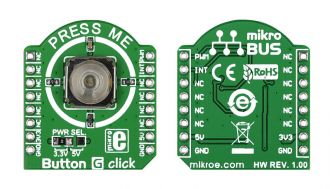
We strongly encourage users to use Package manager for sharing their code on Libstock website, because it boosts your efficiency and leaves the end user with no room for error. [more info]

Rating:
Author: MIKROE
Last Updated: 2018-11-07
Package Version: 1.0.0.1
mikroSDK Library: 1.0.0.0
Category: Pushbutton/Switches
Downloaded: 3807 times
Followed by: 8 users
License: MIT license
Button G click is the simplest solution for adding a single pushbutton to your design. The button itself is transparent, 6.8mm in diameter and has a green LED backlight. When pressed, it sends an interrupt signal to the target board microcontroller. The backlight LED is controlled separately through the mikroBUSâ„¢ PWM pin.
Do you want to subscribe in order to receive notifications regarding "Button G click" changes.
Do you want to unsubscribe in order to stop receiving notifications regarding "Button G click" changes.
Do you want to report abuse regarding "Button G click".
